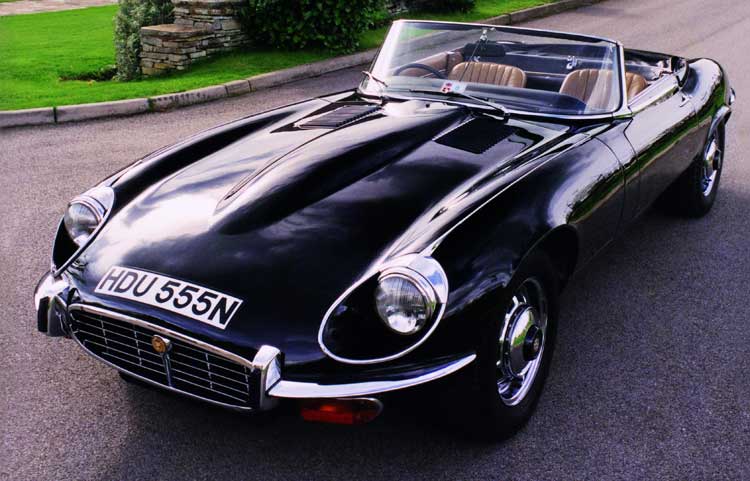Jaguar E-Type
The E-type was the first must-have sports car. Giles Chapman fondly recalls the original babe-magnet

he facts about the Jaguar E-type are etched into every car nut's consciousness: it was derived from a racing car; it was designed by an aerodynamics boffin, not a "stylist"; its stiff chassis and supple suspension gave it a smooth ride and great road-holding.
Normal people, meanwhile, know the E-type as an icon of 1960s freedom - a performance car with a bird-pulling image. "The greatest crumpet-catcher known to man," as US journalist Henry Manney described it.
Trevor Baylis, inventor of the clockwork radio, is one former E-type owner who thrived on the car's macho appeal. "I was Jack-the-lad then," he says. "Sporting around London in a buffalo jacket at the wheel of my E-type. One girl hopped in for a lift and stayed for 18 months. Now I'm into my Viagra years, maybe an E-type would have the same effect."
The E-type was unveiled at the 1961 Geneva Motor Show and became an instant must-have. Its aggressive, dart-like profile, bulging bonnet and tapering tail were like nothing else on the road.
Jaguar's Malcolm Sayer had taken the sleek contours of the D-type that won Le Mans in 1955, 1956 and 1957 and made them work in a road car, while adding necessities such as bumpers and a proper hood. A front number plate would have ruined the looks and aerodynamics, so owners had to put a sticker on the bonnet.
Jaguar knew it had a legend on its hands. The performance was blistering: the 3.8-litre straight-six motor coaxed 149mph out of the roadster; the coupé hit the magic 150mph mark.
Jaguar took 500 orders at the Geneva launch. A month later, in April 1961, the car was at the New York International Auto Show and six sold in the first half-hour. "I want that car and I want it now," barked Frank Sinatra.
And why not? The E-type was a steal. The roadster was £2,097 on-the-road. The Aston Martin DB4 cost £4,084 but could only manage 140mph, while a Ferrari 250GT cost megabucks at £6,469. By contrast, a small family car like the Triumph Herald cost £708, and an average house about £2,700. So if you were on the up, like George Best, George Harrison and James Bond composer John Barry, an E-type was an indulgence your manager would sanction. Owners overlooked the E-type's cranky four-speed gearbox and four-wheel disc brakes that required a he-man shove to work properly.
Jaguar did not rest on its laurels. As boat-loads of E-types set sail for California, where they were sold as the XKE, it set about improving the car. A bigger 4.2-litre engine from 1964 had more torque and came with a vastly improved gearbox, better brakes and comfier seats.
In 1966, a two-plus-two "family" version - and even an automatic option for the ageing lothario - were offered, and the car's raw sporting power began to diminish. But real middle-aged spread set in with the Series II in 1968. The sleek headlight covers were dropped and bigger bumpers fitted on safety grounds, and US pollution laws demanded a less powerful engine. As the mid-sixties Swinging London scene faded, the E-type was getting a slightly embarrassing aura.
A white E-type featured in the corny opening credits of Simon Dee's Dee-Time chat show shortly before the DJ was ejected from our screens, while its status as a disposable used motor was confirmed when two were destroyed in front of a barely-flinching Michael Caine in The Italian Job. People starting lampooning the E-type; maybe my dad's groaningly awful jokes ("What's orange and does 150mph?" "Er, dunno, Dad". "An E-type carrot") echoed nationwide.
The E-type received a welcome image boost in 1971 when Jaguar used the car as a showcase for its first V12, a magnificent engine that turned the E-type into a powerful and unusually silent tourer: a genuine 150mph machine.
But those were anything but ebullient days. In the crisis-gripped Britain of 1974, few people wanted to throw £3,343 at a V12 roadster. Jaguar dealers had real difficulty selling the last 49 examples, a limited edition in jet black paint with a commemorative plaque.
Still, they built 72,007 Jaguar E-types. And that's well over twice the number of all Aston Martins made, ever.
Join our commenting forum
Join thought-provoking conversations, follow other Independent readers and see their replies
Comments